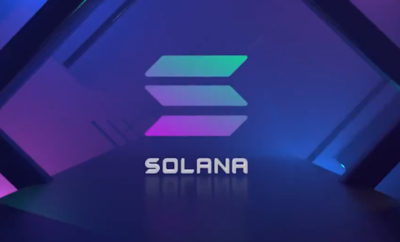Solana
Solana is a blockchain and an ecosystem of dApps. It uses the Proof-of-stake (PoS) consensus algorithm along with the Proof of History (PoH) algorithm. The project was founded by Anatoly Yakovenko, Greg Fitzgerald, Stephen Akridge, Raj Gokal and Zed Zed in 2017. Solana has its own Solana token (SOL). Its mainnet beta launched in March 2020.

Solana is headquartered in Geneva, Switzerland.
Description
Solana is an open source project and it addresses the scalability trilemma. Solana uses the PoH (Proof of History) algorithm that would potentially allow 710,000 transactions per second (TPS). As of April 2022 there are around 1600 Solana nodes, and its block time is 400ms.
Solana offers its ecosystem of dApps, with its own Serum DEX.
History
Solana was founded by Anatoly Yakovenko, Greg Fitzgerald, Stephen Akridge, Raj Gokal, and Zed Zed. In November 2017, Anatoly Yakovenko published a draft of his whitepaper describing the PoH Proof of History algorithm. PoH is designed to solve the blockchain scalability trilemma. On February 13, 2018, Greg Fitzgerald, who was Yakovenko’s colleague at Qualcomm, began implementing the concept described in Yakovenko’s whitepaper. It was then published at GitHub. On February 28, the first release of the project took place, and it demonstrated 10,000 transactions per half a second.
The project was first called Loom. However, the Loom team decided to rebrand to Solana after the emergence of a third-party Loom Network project on Ethereum to avoid confusion. “Solana” refers to Solana Beach in San Diego, where Yakovenko, Fitzgerald and Akridge lived for 3 years working for Qualcomm.
In 2019, Solana launched Tour de SOL, an event designed to uncover vulnerabilities of the Solana testnet.
Solana mainnet beta launched in March 2020.
How it Works
Solana is a pBFT-like PoS blockchain. Solana uses the PoS (Proof-of-stake) consensus mechanism modified and improved by the PoH (Proof of History) algorithm. PoS consensus is used to monitor PoH processes and verifies each sequence of blocks created by PoH.
To write smart contracts, or the so-called “Programs”, Solana uses Rust, C and C++ .
Proof of History (PoH)
The proof of history algorithm, PoH, is an improved version of PoS (Proof-of-stake) consensus. PoH solves the problem of standardized clocks being absent in blockchains. In blockchains that do not use the PoH algorithm, every node needs to confirm transaction time. PoH shows the same time on every node of the network. PoH is a sequence of calculations that makes it possible to cryptographically check the time interval between two events. Thus, PoH ensures the trustless nature of the blockchain.
PoH is a high-frequency VDF, verifiable delay function, and acts as clocks in Solana. Each node is scheduled to take the position of the “leader” node to stake blocks in the network.
Innovations
In addition to the PoH algorithm, the Solana team has developed other technologies to improve the blockchain performance:
- Tower BFT, a pBFT-like consensus algorithm optimized for PoH;
- Turbine, Solana’s block-propagation technique, that uses the UDP, User Datagram Protocol, to conduct transactions;
- using Gulf Stream transactions can be made without using mempools, and validators are predefined;
- Sealevel is a virtual machine that allows to process transactions in parallel;
- Pipelining is “a transaction processing unit for validation optimization”;
- Cloudbreak is a horizontally scaled accounts’ database;
- Archivers is a distributed ledger network of nodes.
SOL Token
SLP is the standard for SOL tokens. SLP is an analogue of ERC20 in Ethereum. SOL is used as a utility token in Solana. Its functions include transaction fee payment and staking tokens as part of the PoS consensus mechanism. SOL holders can become validators. Another function of SOL is to create dApps on Solana.

“Lamports”, named after Leslie Lamport, are fractions of SOL. 1 lamport is 0.000000001 SOL.
SOL is both inflationary and deflationary. SOL’s annual initial inflation rate is 8% and it will decrease by 15% each year until it reaches 1.5%. 1.5% will become its long-term fixed inflation rate. SOL does not have a strict limit on the token supply. However, as a part of its deflationary model, Solana protocol burns a portion of its transaction fees.
As of April 2022, there are 326,220,790 SOL tokens in circulation, according to Coingecko.
Tokenomics
16.23% of SOL was sold at an initial seed sale, Solana team holds 12.79%, 12.92% were released for the founding sale. The Solana Foundation holds 10.46% of the tokens. The remaining are yet to be released, or are already released for private and public sales.
Criticisms
The main criticism is that Solana’s level of decentralization is very low, Solana Foundation being the sole developer of Solana’s core nodes. Solana’s high requirements for hardware and bandwidth of validators result in fewer users suiting these requirements and being able to become validators.
Solana outages
On September 14, 2021, Solana was out of service for 16 hours due to a flood of transactions pushing the network past its limits resulting in a network forking . The team had to restart the whole network to resume its work.
In January 2022, Solana experienced 6 network outages in a row, including an outage on January 21 from 12am to 8pm on January 22. On January 22, SOL lost its value by 30%. Solana Promotion In August 2020, Solana launched its Serum DEX. In 2021, Solana started supporting USDC on its platform , and Tether launched its USDT on Solana. In early 2021, SOL cost $1.5, and by November it increased by 17.500% to cost $275. On April 7, 2022, OpenSea started supporting NFTs built on Solana in beta.